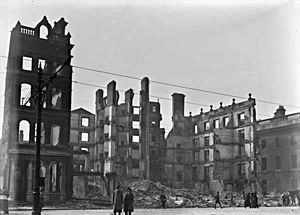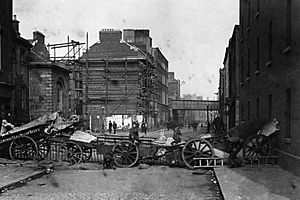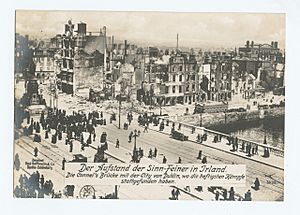Property Losses (Ireland) Committee facts for kids
The Property Losses (Ireland) Committee was a special group set up in Ireland in 1916. Its main job was to figure out how much money people should get for buildings and belongings damaged or destroyed during the Easter Rising. This committee looked at over 7,000 claims from people and businesses, mostly in Dublin, but also from other parts of Ireland. They looked at damage caused by British forces, Irish rebels, and even looters. The committee sent its final report to the British government in April 1917, and then money was paid out to help people rebuild and recover.
Why the Committee Was Needed

The Easter Rising in April 1916 caused a lot of damage, especially in central Dublin. Many buildings were destroyed, mostly by British forces using artillery and even a patrol ship called the HMY Helga. Damage also came from gunfights, soldiers and rebels taking over buildings, and widespread looting.
Areas like Sackville Street and Henry Street were hit very hard. Other streets like Abbey Street, Prince's Street, North Earl Street, Marlborough Street, and Eden Quay also saw many damaged and looted buildings.
For example, the Royal Hibernian Academy building burned down. This meant over 500 artworks, fine art prints, and books were lost. Many businesses in central Dublin, especially near the River Liffey, were also affected. The Metropole Hotel was completely ruined. Many Dubliners lost personal items too, from bicycles taken for transport to furniture used to build street barricades.
Soon after the Rising, in May 1916, a businessman named William Martin Murphy started the Dublin Fire and Property Losses Association. This group, made up of business owners and property owners, wanted to pressure the Irish Parliamentary Party and the British government to pay for the damage. They wanted money for rebuilding and to help those who lost their businesses or homes.
A group from the Association met with Sir Robert Chalmers, a British official. On May 10, the British Prime Minister, H. H. Asquith, said that the British government would pay for damage caused by its forces. However, he said this would be an ex gratia payment. This means it was a goodwill payment, not because the government legally had to pay.
Politicians in Ireland, like the Lord Lieutenant of Ireland, Lord Wimborne, and Dublin's Lord Mayor, James Gallagher, stressed how important it was to pay compensation. They believed it would help calm the anger among Dubliners. Several Dublin Members of Parliament (MPs) also wrote to Asquith, saying that the money should come from the British government's funds.
Asquith himself visited Ireland in May to see the damage and understand how people felt. One of the first things he did was drive along the ruined Sackville Street. After weeks of talks, a key meeting happened on June 9 at Dublin Castle. The Association, Irish MPs (led by John Redmond), and the Home Secretary Herbert Samuel were all there. After this meeting, the British government decided to create a committee. They hoped this committee would help calm feelings among the Irish people.
How the Committee Worked
On June 15, 1916, Lord Wimborne officially set up the Property Losses (Ireland) Committee. It had three members chosen by Lord Wimborne:
- Sir William Goulding, a Dublin businessman, was the chairman.
- William E Osborn from London.
- Samuel Pipkin from the Atlas Assurance Company in London.
The committee's secretary was James J Healy. They had their first meeting on June 21, 1916. The committee's original name, "Destroyed Property Committee," was changed to sound less harsh.
The committee had three main jobs:
- First, to find out how much insurance people had for fire damage.
- Second, to figure out how much insurance companies would have paid if the damage was from an accidental fire.
- Third, to suggest how to fairly help people who didn't have insurance. They also had to decide if insured people should get extra help because of the special situation of the Easter Rising.
At first, the committee only wanted to help businesses or people who had no insurance or only partial insurance. But some insurance companies refused to pay for damage caused by "acts of war." So, after pressure from the Association, the rules were changed, and the committee's work became much wider. However, the committee refused to pay for "consequential loss." This meant they wouldn't pay for things like lost customers or fresh food that spoiled.
Claims were split into two types: damage to buildings and damage to contents (things inside buildings). People and businesses filled out a special form to make a claim. Many forms included extra papers like police reports or building plans if a whole building was destroyed. The police checked all claims. People who were involved with the rebel forces could not get compensation. Three Irish companies were hired to check claims over £100.
Most claims were for small items. These included jewelry left for repair or personal items belonging to people who worked in the damaged businesses. Claims were made for things like shoes and clothing.
Several artists, including Jack Butler Yeats, Madeline Green, and John Lavery, made claims for items lost in the Royal Hibernian Academy fire. Artist Harry Clarke and poet Lennox Robinson also made claims for products lost when the Maunsel and Company Limited building was destroyed. Many businesses claimed for lost goods, especially due to the widespread looting that started soon after the Rising began. Outside Dublin, there were also large claims related to looting in County Wexford and County Galway.
The committee's Final Report was given to the British government on April 7, 1917. It gave a detailed summary of the claims and how the committee worked. It also showed how much money was recommended for payment. The report pointed out that most claims were fair. It also highlighted that there was no firefighting right after the Rising and that the police failed to stop looting.
Out of 7,001 claims, 6,236 were approved for compensation in the final report. The total amount claimed was about £2.79 million (which is like over £191.8 million today!). The approved claims added up to about £2.63 million. The committee recommended paying £1.84 million, which was about 70 percent of the approved amount.
This money was given as goodwill grants. An extra £700,000 loan was also given to the Dublin Corporation for rebuilding work. The biggest payments were for the 210 cases where properties had to be completely rebuilt. The largest payment was £77,292 to Clerys for its destroyed shop on Sackville Street.
Many smaller claims were for just a few pounds. For example, Daniel Murphy Ltd received £2 16s for pork taken by looters at Kingsbridge Station. About 765 applications were rejected, totaling £159,350. George Noble Plunkett and his wife made four claims for money, jewelry, and personal items they said soldiers stole, plus property damage. None of their claims were approved. Twenty-eight applications were withdrawn. The report did not include losses to government buildings, so the damage to the General Post Office, Dublin was not counted.
Money for rebuilding was given out in stages. People had to show a certificate from their architect or builder to get the funds, which sometimes caused delays. The money came from HM Treasury after the Dublin Reconstruction (Emergency Provisions) Act 1916 was passed by the UK Parliament. Dublin's mayor, James Gallagher, helped make sure this law was passed.
After the report was submitted, all the claim files and paperwork were kept in Dublin Castle. In 1986, these materials were moved to the National Archives of Ireland. The Archives cleaned and digitized the collection in 2009, making them available for everyone to see.



